 Movie stars were always willing to give each other a hand. 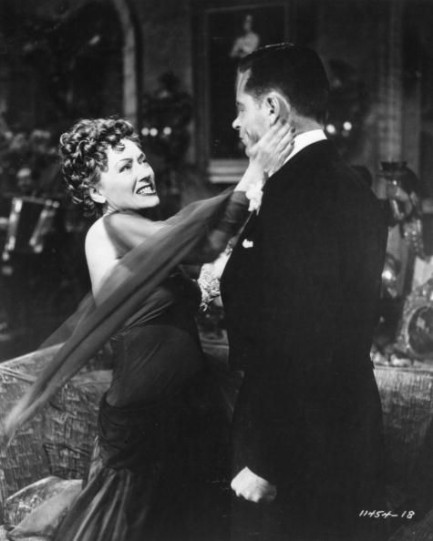
Once again we've been struck, so to speak, by the sheer number of cinema promo images featuring actors and actresses pretending to slap each other. They just keep turning up. The above shot is more about the neck than the face, but it still counts, as Gloria Swanson slaps William Holden in 1950's Sunset Boulevard. Below we have a bunch more, and you can see our previous collection at this link. Since we already discussed this phenomenon we won't get into it again, except briefly as follows: pretend slaps, film is not reality, and everyone should try to remember the difference. Many slaps below for your interest and wonder. 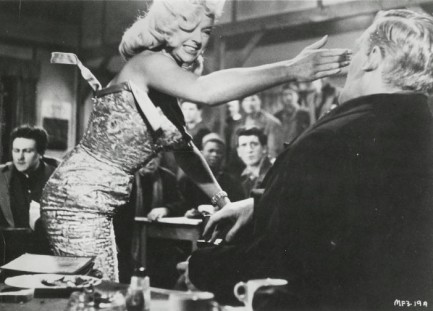 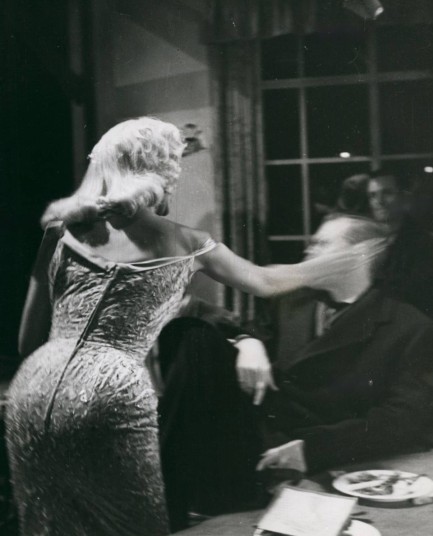 Diana Dors smacks Patrick Allen blurry in 1957's The Long Haul. Diana Dors smacks Patrick Allen blurry in 1957's The Long Haul.
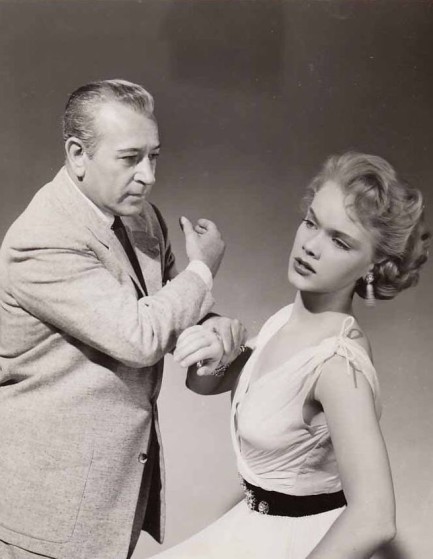 Mob boss George Raft menaces Anne Francis in a promo image made for 1954's Rogue Cop. Mob boss George Raft menaces Anne Francis in a promo image made for 1954's Rogue Cop.
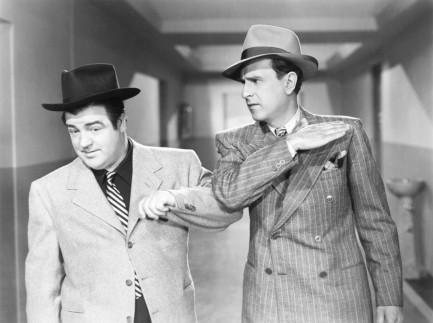 Bud Abbott gets aggressive with Lou Costello in 1945's Here Come the Co-Eds. Bud Abbott gets aggressive with Lou Costello in 1945's Here Come the Co-Eds.
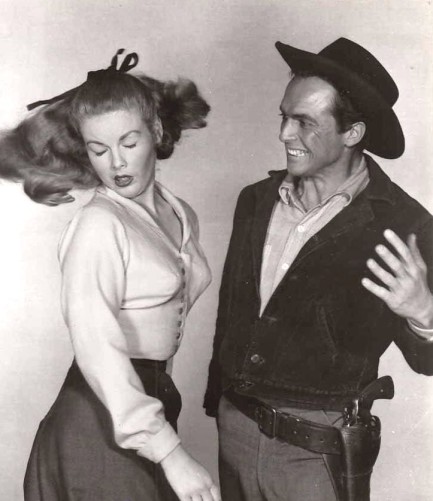 Jo Morrow takes one from black hat Jack Hogan in 1959's The Legend of Tom Dooley. Jo Morrow takes one from black hat Jack Hogan in 1959's The Legend of Tom Dooley.
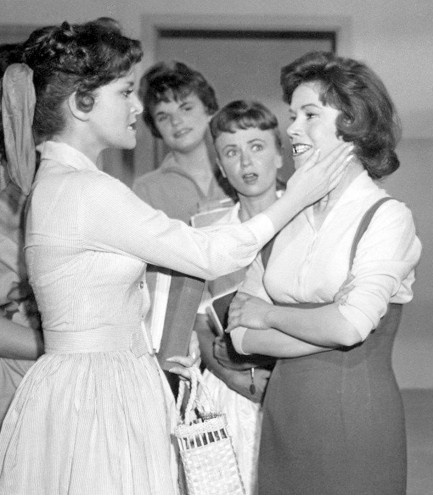 Chris Robinson and Anita Sands get a couple of things straight about who's on the yearbook committee in Diary of High School Bride. Chris Robinson and Anita Sands get a couple of things straight about who's on the yearbook committee in Diary of High School Bride.
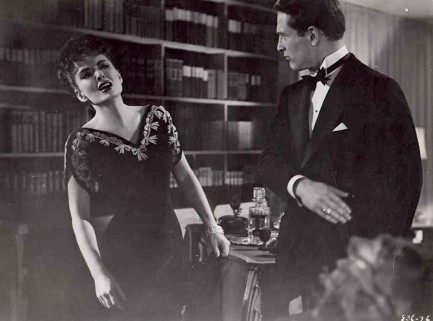 Paul Newman and Ann Blyth agree to disagree in 1957's The Helen Morgan Story. Paul Newman and Ann Blyth agree to disagree in 1957's The Helen Morgan Story.
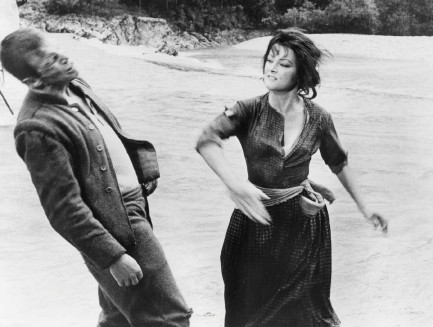 Verna Lisi shows Umberto Orsini who gives the orders in the 1967 film La ragazza e il generale, aka The Girl and the General. Verna Lisi shows Umberto Orsini who gives the orders in the 1967 film La ragazza e il generale, aka The Girl and the General.
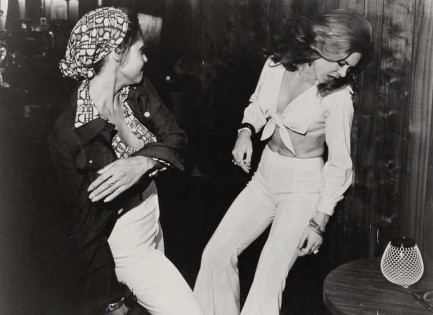 What the fuck did you just call me? Marki Bey slaps Betty Anne Rees loopy in the 1974 horror flick Sugar Hill. What the fuck did you just call me? Marki Bey slaps Betty Anne Rees loopy in the 1974 horror flick Sugar Hill.
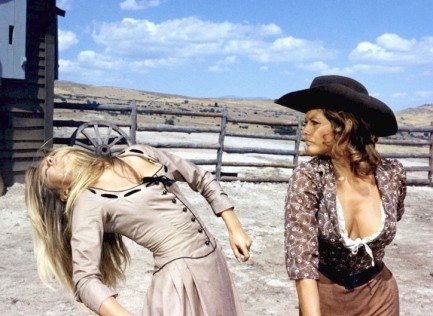 Claudia Cardinale slaps (or maybe punches—we can't remember) Brigitte Bardot in the 1971 western Les pétroleuses, known in English for some reason as The Legend of Frenchie King. Claudia Cardinale slaps (or maybe punches—we can't remember) Brigitte Bardot in the 1971 western Les pétroleuses, known in English for some reason as The Legend of Frenchie King.
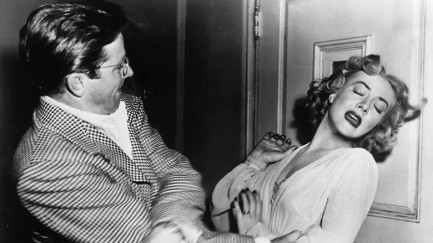 Audrey Totter reels under the attentions of Richard Basehart in 1949 Tension. We're thinking it was probably even more tense after this moment. Audrey Totter reels under the attentions of Richard Basehart in 1949 Tension. We're thinking it was probably even more tense after this moment.
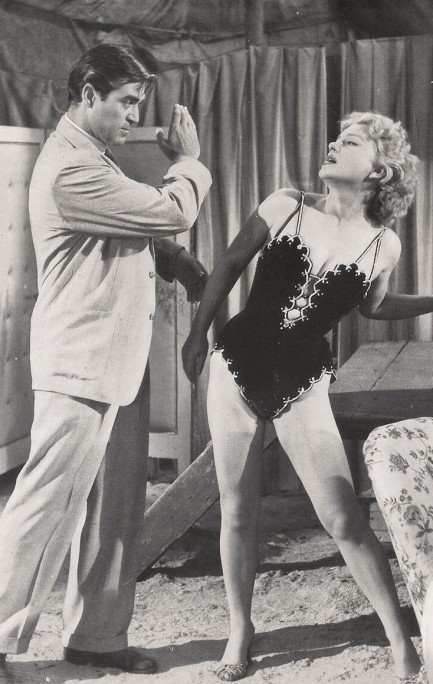 Anne Baxter tries to no avail to avoid a slap from heel Steve Cochran in 1954's Carnival Story. Anne Baxter tries to no avail to avoid a slap from heel Steve Cochran in 1954's Carnival Story.
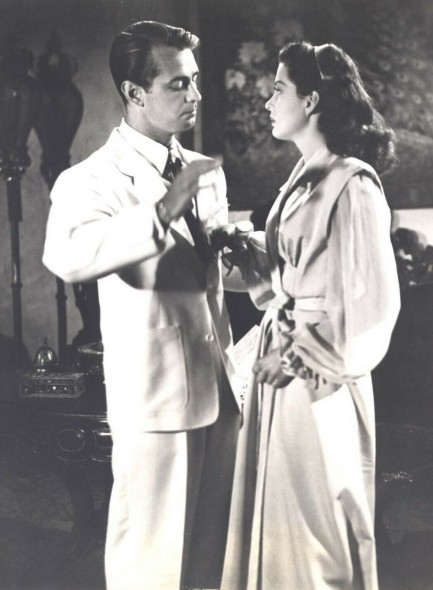 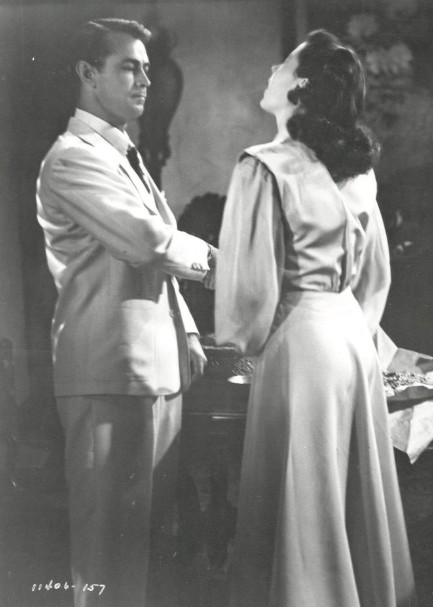 Though Alan Ladd was a little guy who Gail Russell probably could have roughed up if she wanted, the script called for him to slap her, and he obeyed in the 1946 adventure Calcutta. Though Alan Ladd was a little guy who Gail Russell probably could have roughed up if she wanted, the script called for him to slap her, and he obeyed in the 1946 adventure Calcutta.
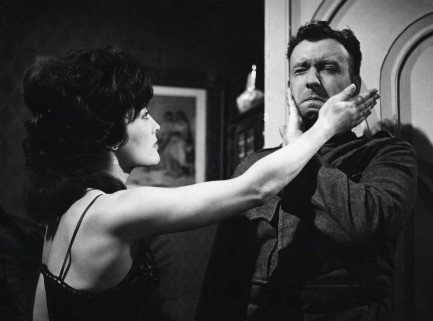 Peter Alexander guards his right cheek, therefore Hannelore Auer crosses him up and attacks his left in 1964's Schwejk's Flegeljahre, aka Schweik's Years of Indiscretion. Peter Alexander guards his right cheek, therefore Hannelore Auer crosses him up and attacks his left in 1964's Schwejk's Flegeljahre, aka Schweik's Years of Indiscretion.
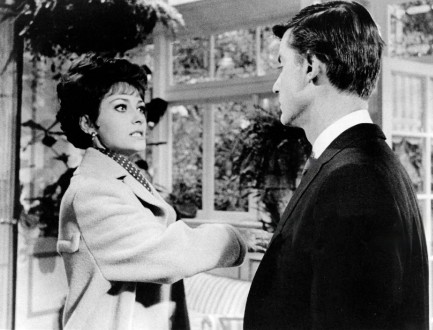 Elizabeth Ashley gives Roddy McDowall a facial in in 1965's The Third Day. Elizabeth Ashley gives Roddy McDowall a facial in in 1965's The Third Day.
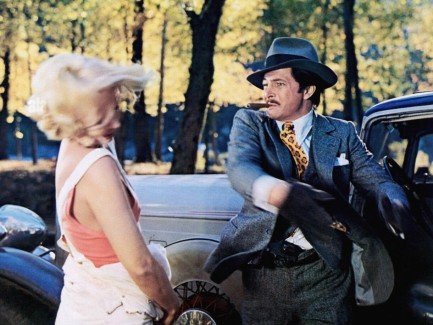 Tony Anthony slaps Lucretia Love in 1972's Piazza pulita, aka Pete, Pearl and the Pole. Tony Anthony slaps Lucretia Love in 1972's Piazza pulita, aka Pete, Pearl and the Pole. 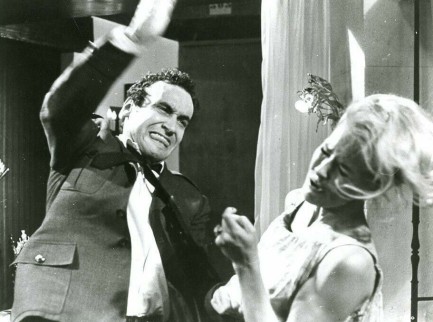 André Oumansky goes backhand on Lola Albright in 1964's Joy House. André Oumansky goes backhand on Lola Albright in 1964's Joy House.
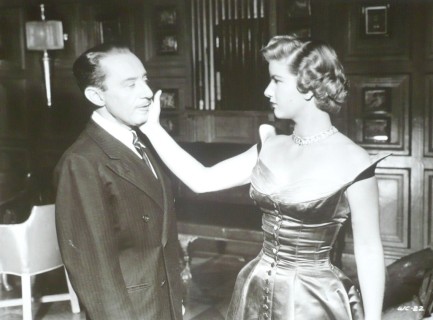 Frank Ferguson catches one from Barbara Bel Geddes in the 1949 drama Caught. Frank Ferguson catches one from Barbara Bel Geddes in the 1949 drama Caught.
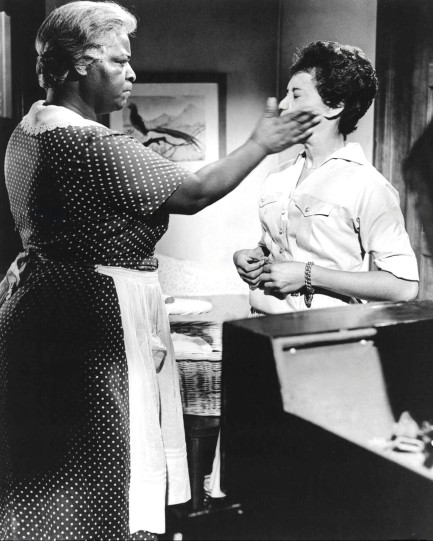 This looks like a real slap, so you have to credit the actresses for their commitment. It's from 1961's Raisin in the Sun and shows Claudia McNeil rearranging the face of Diana Sands. This looks like a real slap, so you have to credit the actresses for their commitment. It's from 1961's Raisin in the Sun and shows Claudia McNeil rearranging the face of Diana Sands.
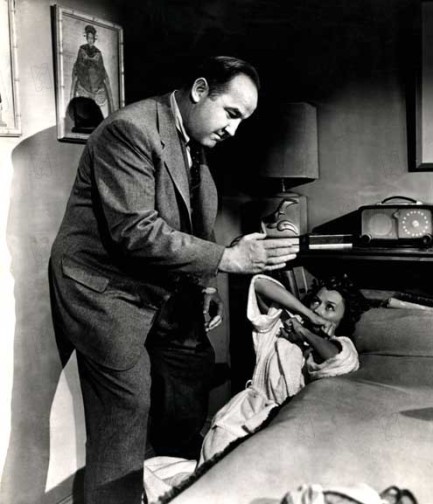 Gloria Grahame finds herself cornered by Broderick Crawford in 1954's Human Desire. Gloria Grahame finds herself cornered by Broderick Crawford in 1954's Human Desire.
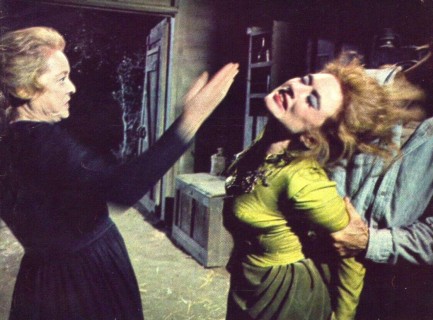 Bette Davis, an experienced slapper and slappee, gets a little assistance from an unidentified third party as she goes Old West on Amanda Blake in a 1966 episode of Gunsmoke called “The Jailer.” Bette Davis, an experienced slapper and slappee, gets a little assistance from an unidentified third party as she goes Old West on Amanda Blake in a 1966 episode of Gunsmoke called “The Jailer.”
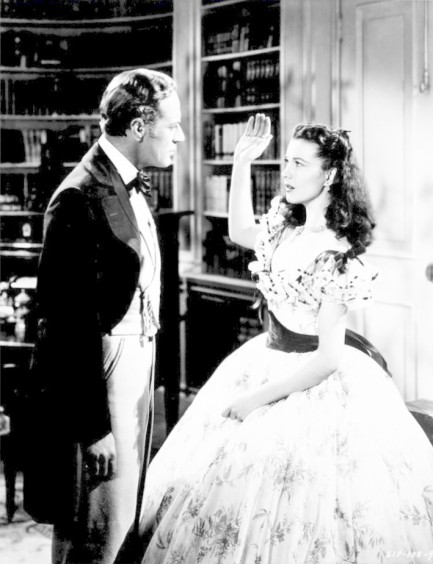 There are a few slaps in 1939's Gone with the Wind, so we had our pick. We went with Vivien Leigh and Leslie Howard. There are a few slaps in 1939's Gone with the Wind, so we had our pick. We went with Vivien Leigh and Leslie Howard.
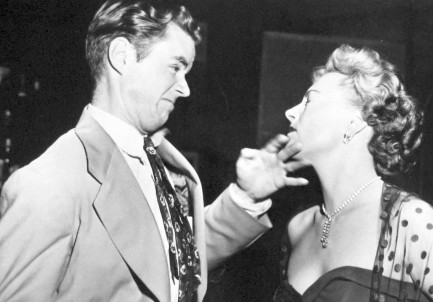 Virginia Field takes one on the chin from Marshall Thompson in Dial 1119. Virginia Field takes one on the chin from Marshall Thompson in Dial 1119.
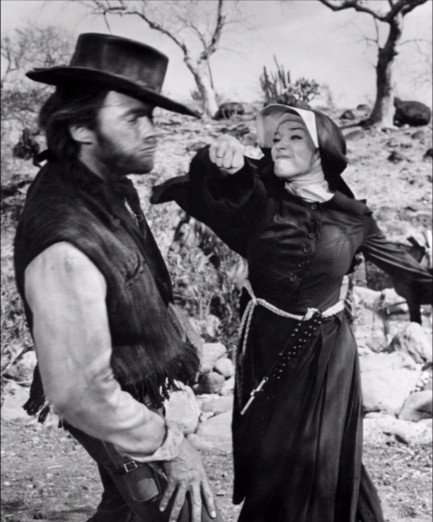 Clint Eastwood absorbs a right cross from nun Shirley MacLaine in 1970's Two Mules for Sister Sara. Clint Eastwood absorbs a right cross from nun Shirley MacLaine in 1970's Two Mules for Sister Sara.
 At this point she has no idea which way to turn. 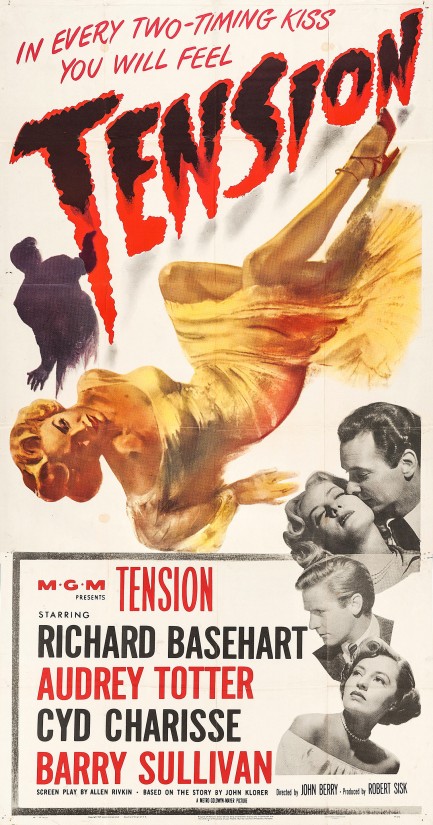
Above is an alternate promo poster for Tension, with cool upside down imagery of a figure representing star Audrey Totter. We say “representing” because it doesn't really look like Totter, but it's her alright. It was modeled after a promo photo. The movie also starred Richard Basehart and the incandescent Cyd Charisse. We talked about this last year, so if you want to know more, click here. And if you want to see more of Totter click here, or Charisse (a must), click here and here. Tension premiered today in 1949.
 Anyone can be calm until the cops start poking around. 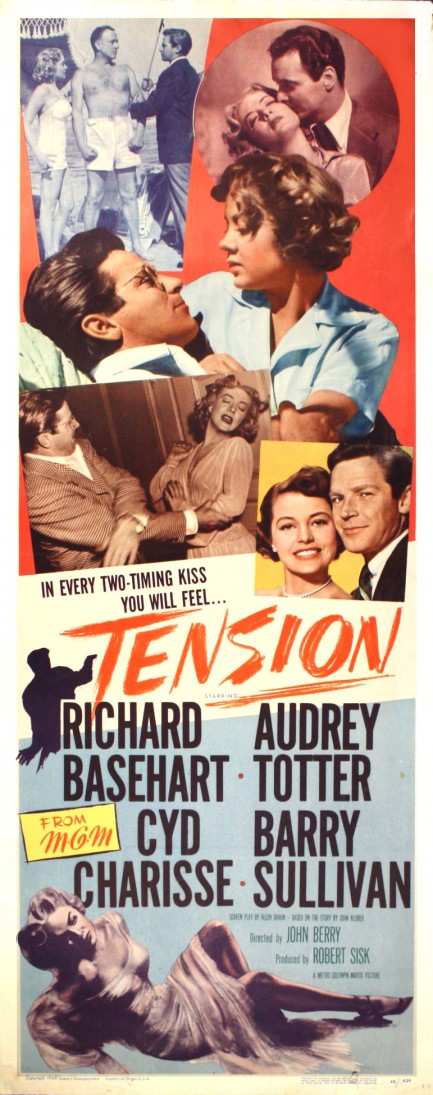
Tension, for which you see an excellent promo poster above and two more below, is an unlikely but interesting film noir about a mild mannered pharmacist played by Richard Basehart, who's married to hot-to-trot Audrey Totter and discovers she's cheating on him. When she finally leaves him for an apelike creature played by Lloyd Gough, and the ape issues Basehart a solid beating, he decides he's been pushed too far. You'd think that pharmacists would be among that select group of people you really don't want to anger, but this particular pharmacist has a much more elaborate scheme in mind than just a dose of chemicals, and his determination to commit an untraceable murder leads to him building a very traceable double life. In that second life things get complicated when he meets lovely Cyd Charisse, who he wants to make a permanent addition to his future.
Basehart's plot will not go as intended, of course, but the way in which it fails is a surprise, and the complications keep piling up. Tension has flaws, to be sure. The detective played by Barry Sullivan does things that, as far as we know, would get any murder case tossed out of court, but you have to go with it, since he tells you from the jump he'll do anything to solve a case. The plusses of the movie outweigh any weird bits, and with Totter on board, it's probably a must-see. The sinuous clarinet melody she gets every time she appears onscreen is over-the-top, but she's a major scenery chewer anyway, so it actually fits. We didn't like her in Lady in the Lake, but she's delivered in everything else we've seen—this flick, particularly. And Charisse, by the way, gets one of the better entrances we've seen in vintage cinema, straddling two high railings with a camera in hand. She's as hot as a human being can get. Tension premiered today in 1949.
 To be a sidewalk pancake or not to be a sidewalk pancake. That is the question. 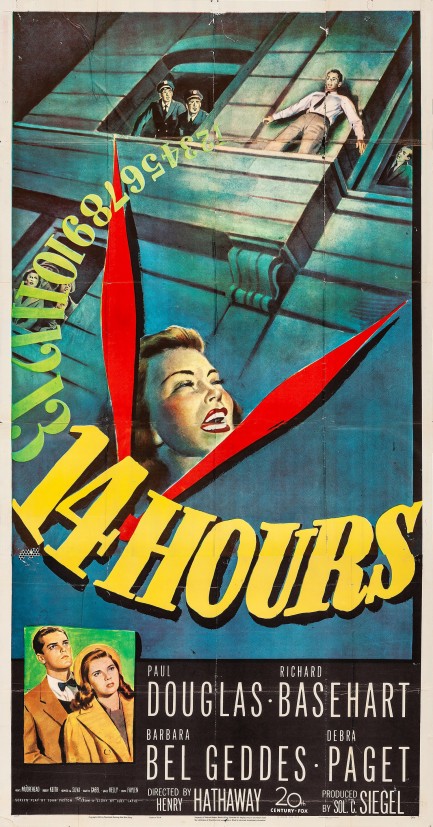
We have a friend who once said that everyone's problems can be boiled down to, “Mommy and daddy didn't love me enough.” We don't agree, but 14 Hours, aka Fourteen Hours, takes that idea and runs with it as far and fast as it can, as Richard Basehart climbs onto a New York City hotel ledge and engages in the eternal existential wrestling match: To be or not to be? Most of the movie takes place on that ledge, as a beat cop played by Paul Douglas tries to talk Basehart out of splattering himself all over 55th Street.
The performances in this film were acclaimed at the time, and it also has an interesting collection of young, soon-to-be stars, including Debra Paget, pretty boy Jeffery Hunter, Barbara Bel Geddes, and the legendary Grace Kelly, who's twenty-two yet plays a mother of two about to be divorced. Yes, there are twenty-two-year-old mothers of two facing divorce, but it feels like a case of shoehorning her into the movie when her role was clearly written for an older actress. But hey, shoehorn away—she's Grace Kelly. She can play King Kong as far as we're concerned.
14 Hours is, on the whole, an involving and speedy flick. It is not a film noir, and we wish IMDB and Wikipedia didn't let their users label every vintage black and white drama a noir. This one is not even close to noir. It has almost none of that genre's standard iconography, and also lacks its required thematic underpinning. The American Film Institute officially calls it a suspense drama. Whatever its category, 14 Hours' ninety-two minutes are entertaining and technically proficient. To watch or not to watch? We say yes. It premiered in the U.S. today in 1951.
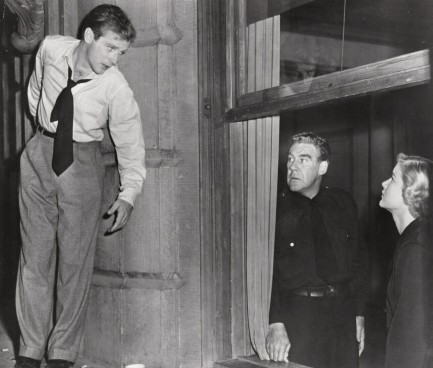 If you'd had sex with me I wouldn't be out here with the pigeons right now. If you'd had sex with me I wouldn't be out here with the pigeons right now.
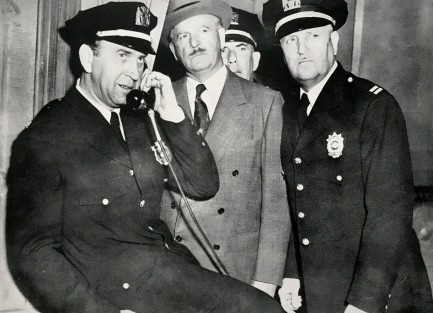 Headquarters? Do not—I repeat do not—eat all the donuts. We'll get this nutjob off the ledge and be back there as quick as we can. Headquarters? Do not—I repeat do not—eat all the donuts. We'll get this nutjob off the ledge and be back there as quick as we can.
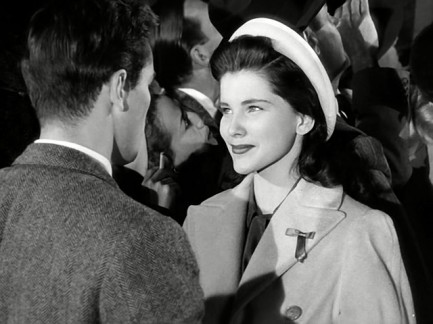 I certainly don't want you to get desperate enough to climb onto a ledge. Let's go to your place and I'll show you what life is all about. I certainly don't want you to get desperate enough to climb onto a ledge. Let's go to your place and I'll show you what life is all about.
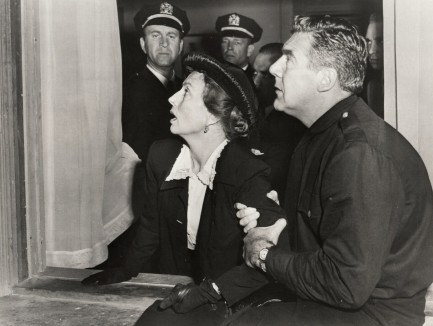 Don't jump, son! Without you there'll be nobody around to listen to me complain about what a loser your father is! Don't jump, son! Without you there'll be nobody around to listen to me complain about what a loser your father is!
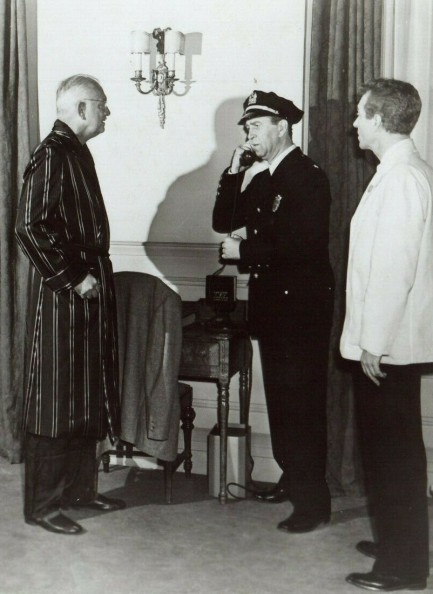 Hello, headquarters? Status check on those donuts. Hello, headquarters? Status check on those donuts.
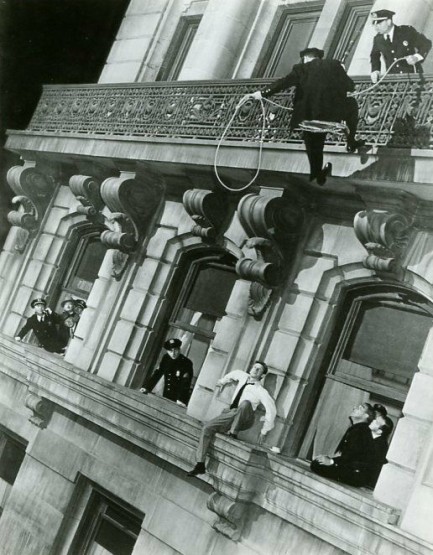 Just cooperate, mister! There are a lot of hungry cops up here! Just cooperate, mister! There are a lot of hungry cops up here!
 Reaching the top isn’t easy. Staying on top is even harder. 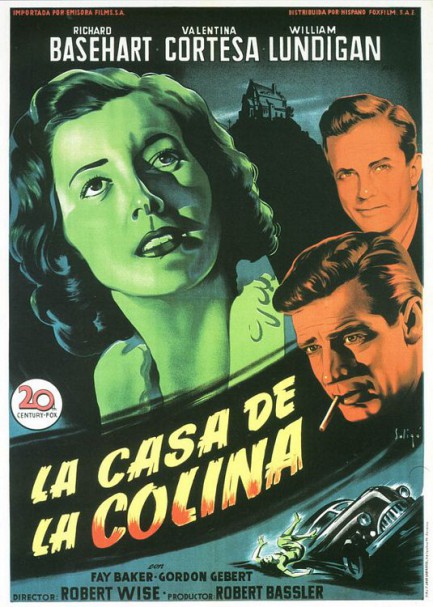
Above is a Spanish poster by Josep Soligó Tena for La casa de la colina, which was originally released in the U.S. as The House on Telegraph Hill. The movie tells the story of a Polish concentration camp survivor—played by Valentina Cortese—who upon release takes the identity of her dead friend, and later insinuates herself into the lives of the dead woman’s San Francisco relatives. This identity swap is the classic Hitchcockian MacGuffin, which is to say it initially seems to be the plot driver, but later isn’t important at all. While Cortese’s labyrinthine lie is always a worrisome background element, the movie is really about how she finds herself embroiled in an inheritance mess and a love triangle. We thought this movie was quite good, but you do have to ignore bits like the improbable placement of a child’s playhouse above a sheer drop (in a sense, another MacGuffin, as the threat of falling has no bearing at all on later developments). Highly recommended movie, and it has nice San Fran exteriors as a bonus. The House on Telegraph Hill premiered in the U.S. in 1951, and as La casa de la colina in Spain today in 1952. See more work from Tena here.
|
 |

The headlines that mattered yesteryear.
1945—Churchill Given the Sack
In spite of admiring Winston Churchill as a great wartime leader, Britons elect
Clement Attlee the nation's new prime minister in a sweeping victory for the Labour Party over the Conservatives. 1952—Evita Peron Dies
Eva Duarte de Peron, aka Evita, wife of the president of the Argentine Republic, dies from cancer at age 33. Evita had brought the working classes into a position of political power never witnessed before, but was hated by the nation's powerful military class. She is lain to rest in Milan, Italy in a secret grave under a nun's name, but is eventually returned to Argentina for reburial beside her husband in 1974. 1943—Mussolini Calls It Quits
Italian dictator Benito Mussolini steps down as head of the armed forces and the government. It soon becomes clear that Il Duce did not relinquish power voluntarily, but was forced to resign after former Fascist colleagues turned against him. He is later installed by Germany as leader of the Italian Social Republic in the north of the country, but is killed by partisans in 1945. 1915—Ship Capsizes on Lake Michigan
During an outing arranged by Western Electric Co. for its employees and their families, the passenger ship Eastland capsizes in Lake Michigan due to unequal weight distribution. 844 people die, including all the members of 22 different families. 1980—Peter Sellers Dies
British movie star Peter Sellers, whose roles in Dr. Strangelove, Being There and the Pink Panther films established him as the greatest comedic actor of his generation, dies of a heart attack at age fifty-four.
|

|
|

It's easy. We have an uploader that makes it a snap. Use it to submit your art, text, header, and subhead. Your post can be funny, serious, or anything in between, as long as it's vintage pulp. You'll get a byline and experience the fleeting pride of free authorship. We'll edit your post for typos, but the rest is up to you. Click here to give us your best shot.

|
|



 Diana Dors smacks Patrick Allen blurry in 1957's The Long Haul.
Diana Dors smacks Patrick Allen blurry in 1957's The Long Haul. Mob boss George Raft menaces Anne Francis in a promo image made for 1954's Rogue Cop.
Mob boss George Raft menaces Anne Francis in a promo image made for 1954's Rogue Cop. Bud Abbott gets aggressive with Lou Costello in 1945's Here Come the Co-Eds.
Bud Abbott gets aggressive with Lou Costello in 1945's Here Come the Co-Eds. Jo Morrow takes one from black hat Jack Hogan in 1959's The Legend of Tom Dooley.
Jo Morrow takes one from black hat Jack Hogan in 1959's The Legend of Tom Dooley. Chris Robinson and Anita Sands get a couple of things straight about who's on the yearbook committee in Diary of High School Bride.
Chris Robinson and Anita Sands get a couple of things straight about who's on the yearbook committee in Diary of High School Bride. Paul Newman and Ann Blyth agree to disagree in 1957's The Helen Morgan Story.
Paul Newman and Ann Blyth agree to disagree in 1957's The Helen Morgan Story. Verna Lisi shows Umberto Orsini who gives the orders in the 1967 film La ragazza e il generale, aka The Girl and the General.
Verna Lisi shows Umberto Orsini who gives the orders in the 1967 film La ragazza e il generale, aka The Girl and the General. What the fuck did you just call me? Marki Bey slaps Betty Anne Rees loopy in the 1974 horror flick Sugar Hill.
What the fuck did you just call me? Marki Bey slaps Betty Anne Rees loopy in the 1974 horror flick Sugar Hill. Claudia Cardinale slaps (or maybe punches—we can't remember) Brigitte Bardot in the 1971 western Les pétroleuses, known in English for some reason as The Legend of Frenchie King.
Claudia Cardinale slaps (or maybe punches—we can't remember) Brigitte Bardot in the 1971 western Les pétroleuses, known in English for some reason as The Legend of Frenchie King. Audrey Totter reels under the attentions of Richard Basehart in 1949 Tension. We're thinking it was probably even more tense after this moment.
Audrey Totter reels under the attentions of Richard Basehart in 1949 Tension. We're thinking it was probably even more tense after this moment. Anne Baxter tries to no avail to avoid a slap from heel Steve Cochran in 1954's Carnival Story.
Anne Baxter tries to no avail to avoid a slap from heel Steve Cochran in 1954's Carnival Story.
 Though Alan Ladd was a little guy who Gail Russell probably could have roughed up if she wanted, the script called for him to slap her, and he obeyed in the 1946 adventure Calcutta.
Though Alan Ladd was a little guy who Gail Russell probably could have roughed up if she wanted, the script called for him to slap her, and he obeyed in the 1946 adventure Calcutta. Peter Alexander guards his right cheek, therefore Hannelore Auer crosses him up and attacks his left in 1964's Schwejk's Flegeljahre, aka Schweik's Years of Indiscretion.
Peter Alexander guards his right cheek, therefore Hannelore Auer crosses him up and attacks his left in 1964's Schwejk's Flegeljahre, aka Schweik's Years of Indiscretion. Elizabeth Ashley gives Roddy McDowall a facial in in 1965's The Third Day.
Elizabeth Ashley gives Roddy McDowall a facial in in 1965's The Third Day. Tony Anthony slaps Lucretia Love in 1972's Piazza pulita, aka Pete, Pearl and the Pole.
Tony Anthony slaps Lucretia Love in 1972's Piazza pulita, aka Pete, Pearl and the Pole. André Oumansky goes backhand on Lola Albright in 1964's Joy House.
André Oumansky goes backhand on Lola Albright in 1964's Joy House. Frank Ferguson catches one from Barbara Bel Geddes in the 1949 drama Caught.
Frank Ferguson catches one from Barbara Bel Geddes in the 1949 drama Caught. This looks like a real slap, so you have to credit the actresses for their commitment. It's from 1961's Raisin in the Sun and shows Claudia McNeil rearranging the face of Diana Sands.
This looks like a real slap, so you have to credit the actresses for their commitment. It's from 1961's Raisin in the Sun and shows Claudia McNeil rearranging the face of Diana Sands. Gloria Grahame finds herself cornered by Broderick Crawford in 1954's Human Desire.
Gloria Grahame finds herself cornered by Broderick Crawford in 1954's Human Desire. Bette Davis, an experienced slapper and slappee, gets a little assistance from an unidentified third party as she goes Old West on Amanda Blake in a 1966 episode of Gunsmoke called “The Jailer.”
Bette Davis, an experienced slapper and slappee, gets a little assistance from an unidentified third party as she goes Old West on Amanda Blake in a 1966 episode of Gunsmoke called “The Jailer.” There are a few slaps in 1939's Gone with the Wind, so we had our pick. We went with Vivien Leigh and Leslie Howard.
There are a few slaps in 1939's Gone with the Wind, so we had our pick. We went with Vivien Leigh and Leslie Howard. Virginia Field takes one on the chin from Marshall Thompson in Dial 1119.
Virginia Field takes one on the chin from Marshall Thompson in Dial 1119. Clint Eastwood absorbs a right cross from nun Shirley MacLaine in 1970's Two Mules for Sister Sara.
Clint Eastwood absorbs a right cross from nun Shirley MacLaine in 1970's Two Mules for Sister Sara.



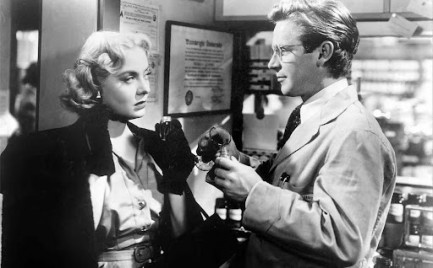
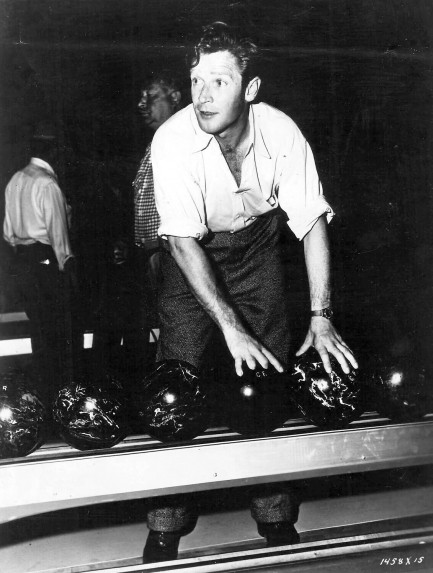
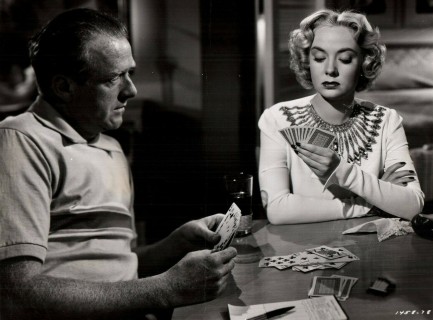
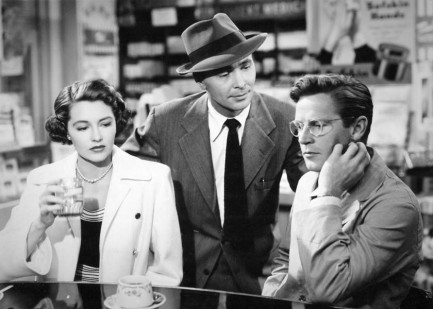
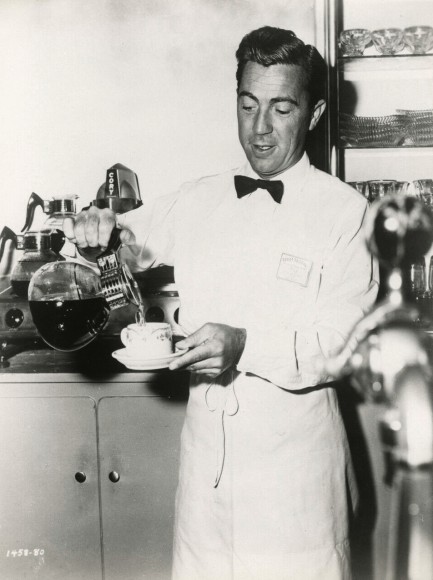
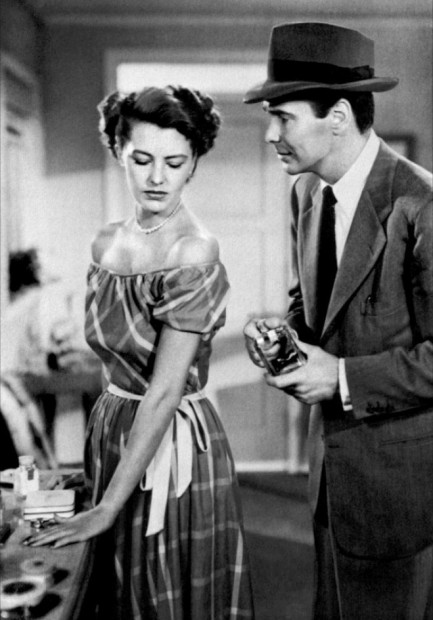
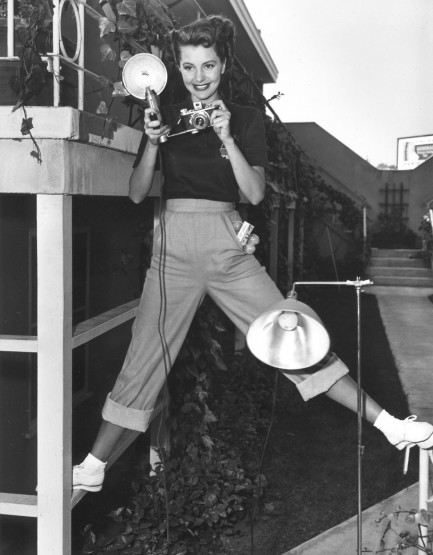

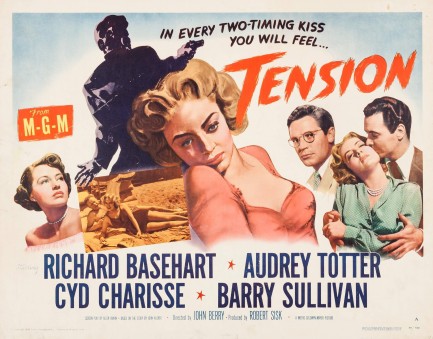
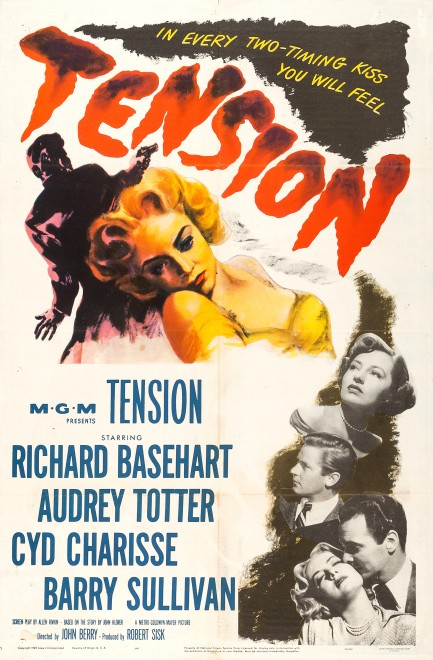


 If you'd had sex with me I wouldn't be out here with the pigeons right now.
If you'd had sex with me I wouldn't be out here with the pigeons right now. Headquarters? Do not—I repeat do not—eat all the donuts. We'll get this nutjob off the ledge and be back there as quick as we can.
Headquarters? Do not—I repeat do not—eat all the donuts. We'll get this nutjob off the ledge and be back there as quick as we can. I certainly don't want you to get desperate enough to climb onto a ledge. Let's go to your place and I'll show you what life is all about.
I certainly don't want you to get desperate enough to climb onto a ledge. Let's go to your place and I'll show you what life is all about. Don't jump, son! Without you there'll be nobody around to listen to me complain about what a loser your father is!
Don't jump, son! Without you there'll be nobody around to listen to me complain about what a loser your father is! Hello, headquarters? Status check on those donuts.
Hello, headquarters? Status check on those donuts. Just cooperate, mister! There are a lot of hungry cops up here!
Just cooperate, mister! There are a lot of hungry cops up here!





































































